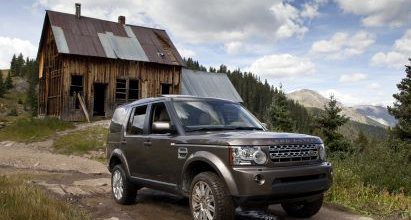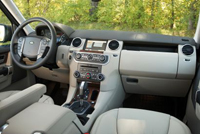
Land Rover LR4 SUV Road Test Review
The Latest Iteration of Discovery SUV
By Bob Plunkett with Jeffray Plunkett
Four nubby tires on a 2011 edition of the mid-size LR4 -- that wily mountain goat disguised as a SUV from Britain's Land Rover -- crunch sand and gravel as the intelligent transfer case distributes huge engine torque between front and rear wheels to maintain tire traction while we creep down the treacherous Black Bear Pass, a two-track trail running over the San Juan Mountains of Colorado with twisty switchbacks hacked into sheer stone-faced cliffs.
One driver's brain protests this dicey descent of a dangerous route where too much wheel slip could send the triple-ton hunk of machinery hurling through thin air to the paved streets of Telluride thousands of feet below.
Strapped tightly in the driver's seat of the LR4, however, we don't sweat the drive because this SUV stocks a substantial assortment of sophisticated mechanical hardware geared for heavy-duty four-wheel-drive (4WD) performance and a load of safety systems to transport us securely down Black Bear Pass -- and in surprising comfort.
Our wagon, renamed LR4 with the re-do of 2010 to mark a fourth generation for Land Rover's Discovery SUV, is marked by a high stance and boxy profile with the stepped roof seemingly floating above a tall wrap of windows. It projects a blunt face with squared clusters of clear-lens headlamps and a distinctive dual-bar grille positioned above the fat-lip front fascia and bumper.
Protective molding bulges around wheel wells on each side and extends beneath the doors.
Air intake louvers, etched into the front fender, foretell of a massive engine aboard.
The roof rises high to boost headroom for passengers in the cabin. And on rear flanks there's a vast picture window which gives the wagon a distinctive look.
In back the tailgate in two-piece clamshell style is asymmetric in shape to reduce the load height with the lower portion closed or trim the distance required to reach inside when the lower flap is open and folded down.
Structure for LR4 combines a ladder-type chassis with a stiff monocoque body.
This is a large package, with the wheelbase length running to 113.6 inches and the wheel track width stretching to 63.2 inches in front and 63.5 inches in back.
Overall length measures 190.1 inches long, the width reaches to 79.6 inches and the roofline tops out at 74.3 inches tall.
The extended length of the structure makes room for an optional third tier of seats in the cabin, and the width adds stability to the wheel track as well as ample elbow room inside for passengers.
 LR4's cabin layout consists of a pair of bucket seats on the front row, a second row bench (split 35/30/35 in three sections) that folds down flat, and the optional third row set of two seats. LR4's cabin layout consists of a pair of bucket seats on the front row, a second row bench (split 35/30/35 in three sections) that folds down flat, and the optional third row set of two seats.
Front buckets, clad in fine leather hides, adjust in multiple directions through electric power controls.
The LR4 also contains armaments to chart a safe course through urban traffic as well as the toughest wilderness. It adds innovations for maneuvering on a trail and a big powertrain that produces massive low-end torque.
The aluminum 5.0-liter V8, with dual-cam configuration and electronic throttle, generates 375 hp at 6500 rpm and 375 lb-ft of torque at only 3500 rpm.
It translates all of that torque through an electronically controlled automatic transmission by ZF of Germany with six forward gears. The shifter stick with H-gate shift pattern for the CommandShift manual mode operates even in lowest range of 4WD.
LR4's 4WD mechanism has a two-speed electronically-shifted transfer case and it's always working, either in high range for normal driving including runs at highway speed or low range for slow-go crawling over rough stuff away from pavement.
A tab is used for switching into the low range -- and LR4 has options for electronically locking of the center and rear differentials.
On the console is a rotary dial for selecting five different terrain settings using Land Rover's patented terrain response system (TRS) that matches various vehicle dynamic systems to the terrain.
Settings include one for pavement cruising, another for slick surfaces like snow or gravel, and three different off-road situations -- mud, sand and rock.
Once a mode is chosen, the TRS goes to work.
It sets up the vehicle in optimum manner for the type of terrain, through electronic controls for suspension ride height via an air suspension system, powertrain response, transmission gear selection, the four-wheel electronic traction control (4ETC), all-terrain dynamic stability control (DSC), hill descent control (HDC), which keeps the wagon's wheels firmly planted on a steep grade, and gradient acceleration control (GAC), which if sensing the vehicle accelerates downhill will automatically pressurize brakes and holds the speed down to 3 mph for up to 20 seconds -- enough time to let the driver regain control.
The electronic air suspension with automatic load-leveling also has multiple modes -- Standard, Access (2.0 inches lower than Standard), Off-Road (2.2 inches higher than Standard), and Extended, which is way up there.
An optional DVD-based navigation system with dashboard touch screen adds a helpful animated video display that shows alignment of all wheels, steering angles, chassis height plus center and rear differential locking.
And a new optional surround camera system employs five cameras to deliver almost a 360-degree view of the vehicle on the dashboard navi screen. Two cameras point forward, two others on each flank face downward, and one at the tail looks rearward. You may choose a camera view from the touch screen, and then zoom in as desired.
We depend on the video display to help guide us safely down the precarious zigzags of Black Bear Pass.
Land Rover LR4 in five-seat configuration provides such standard equipment as twin-zone climate controls, eight-way power controls for front seats, cruise control, power controls to operate the windows and outside mirrors and tailgate, leather upholstery, and an audio kit with AM/FM/CD/MP3 plus auxiliary jack.
LR4's HSE package loads more equipment, such as heat elements in front and second row seats, park distance control forward/rearward, a satellite navigation system and driver information center, Bluetooth wireless connectivity plus 19-inch alloy wheels. HSE LUX package goes further with bi-xenon headlamps, surround cameras, premium leather, cabin mood lighting, a 14-seaker Harman/Kardon audio system and much more.
MSRP for the 2011 LR4 runs upward from $47,650. Visit Land Rover.
FOR MORE ROAD TEST REVIEWS - VISIT RTM'S NEW CAR REVIEW ARCHIVE. |